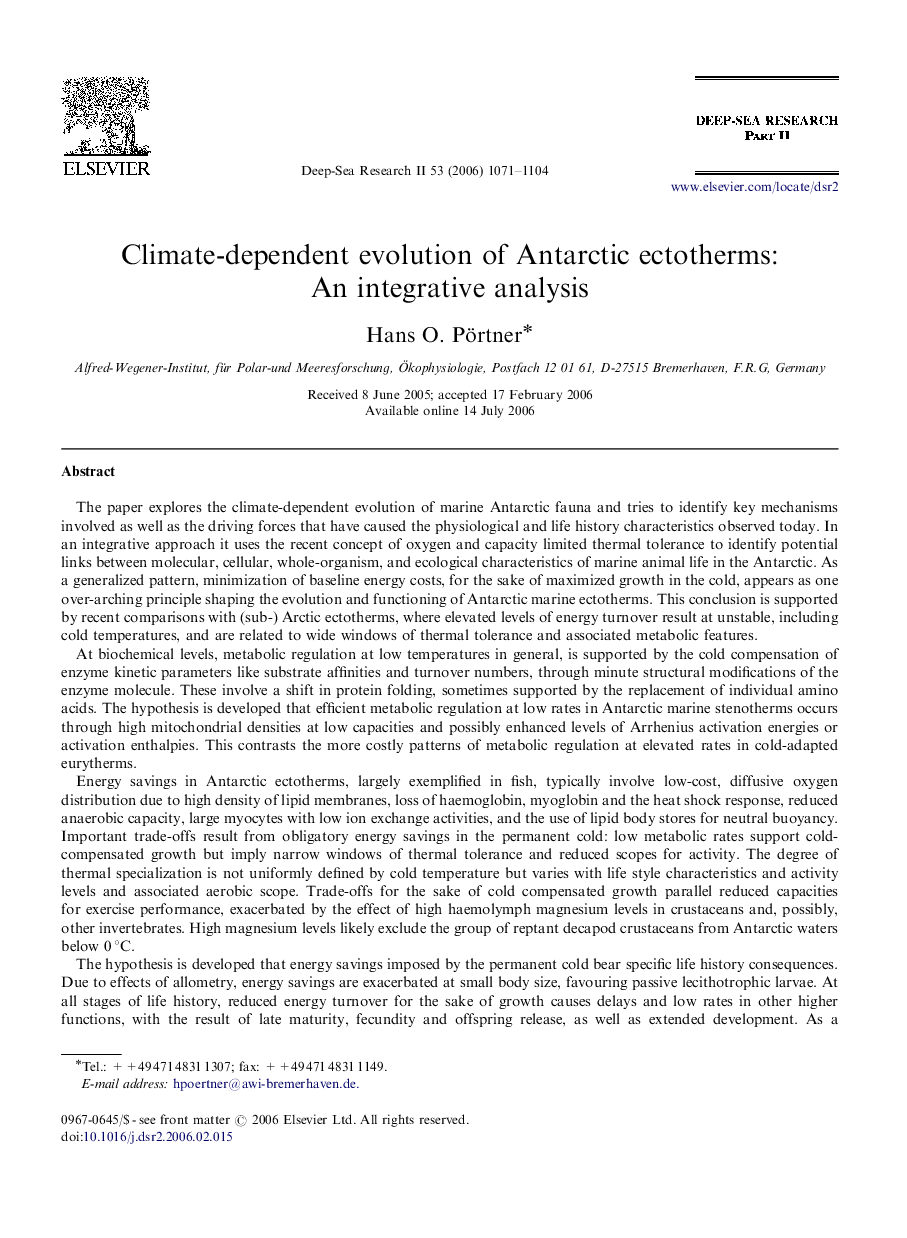| کد مقاله | کد نشریه | سال انتشار | مقاله انگلیسی | نسخه تمام متن |
|---|---|---|---|---|
| 4538514 | 1626516 | 2006 | 34 صفحه PDF | دانلود رایگان |

The paper explores the climate-dependent evolution of marine Antarctic fauna and tries to identify key mechanisms involved as well as the driving forces that have caused the physiological and life history characteristics observed today. In an integrative approach it uses the recent concept of oxygen and capacity limited thermal tolerance to identify potential links between molecular, cellular, whole-organism, and ecological characteristics of marine animal life in the Antarctic. As a generalized pattern, minimization of baseline energy costs, for the sake of maximized growth in the cold, appears as one over-arching principle shaping the evolution and functioning of Antarctic marine ectotherms. This conclusion is supported by recent comparisons with (sub-) Arctic ectotherms, where elevated levels of energy turnover result at unstable, including cold temperatures, and are related to wide windows of thermal tolerance and associated metabolic features.At biochemical levels, metabolic regulation at low temperatures in general, is supported by the cold compensation of enzyme kinetic parameters like substrate affinities and turnover numbers, through minute structural modifications of the enzyme molecule. These involve a shift in protein folding, sometimes supported by the replacement of individual amino acids. The hypothesis is developed that efficient metabolic regulation at low rates in Antarctic marine stenotherms occurs through high mitochondrial densities at low capacities and possibly enhanced levels of Arrhenius activation energies or activation enthalpies. This contrasts the more costly patterns of metabolic regulation at elevated rates in cold-adapted eurytherms.Energy savings in Antarctic ectotherms, largely exemplified in fish, typically involve low-cost, diffusive oxygen distribution due to high density of lipid membranes, loss of haemoglobin, myoglobin and the heat shock response, reduced anaerobic capacity, large myocytes with low ion exchange activities, and the use of lipid body stores for neutral buoyancy. Important trade-offs result from obligatory energy savings in the permanent cold: low metabolic rates support cold-compensated growth but imply narrow windows of thermal tolerance and reduced scopes for activity. The degree of thermal specialization is not uniformly defined by cold temperature but varies with life style characteristics and activity levels and associated aerobic scope. Trade-offs for the sake of cold compensated growth parallel reduced capacities for exercise performance, exacerbated by the effect of high haemolymph magnesium levels in crustaceans and, possibly, other invertebrates. High magnesium levels likely exclude the group of reptant decapod crustaceans from Antarctic waters below 0 °C.The hypothesis is developed that energy savings imposed by the permanent cold bear specific life history consequences. Due to effects of allometry, energy savings are exacerbated at small body size, favouring passive lecithotrophic larvae. At all stages of life history, reduced energy turnover for the sake of growth causes delays and low rates in other higher functions, with the result of late maturity, fecundity and offspring release, as well as extended development. As a consequence, extended life spans evolved due to life history requirements. At the same time, polar gigantism is enabled by a combination of elevated oxygen levels in cold waters, of reduced metabolism and of extended periods of growth at slow developmental rates.
Journal: Deep Sea Research Part II: Topical Studies in Oceanography - Volume 53, Issues 8–10, April–May 2006, Pages 1071–1104